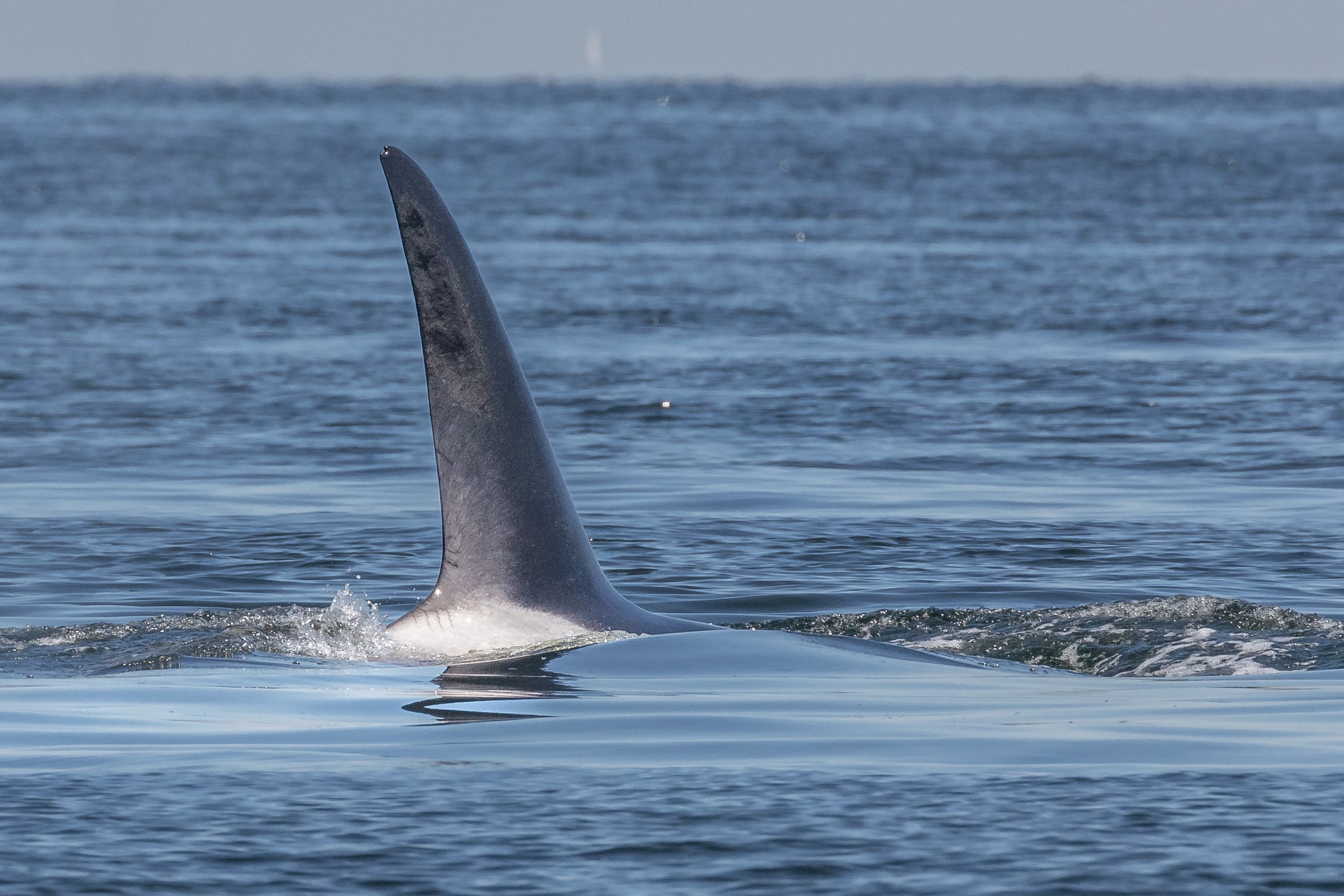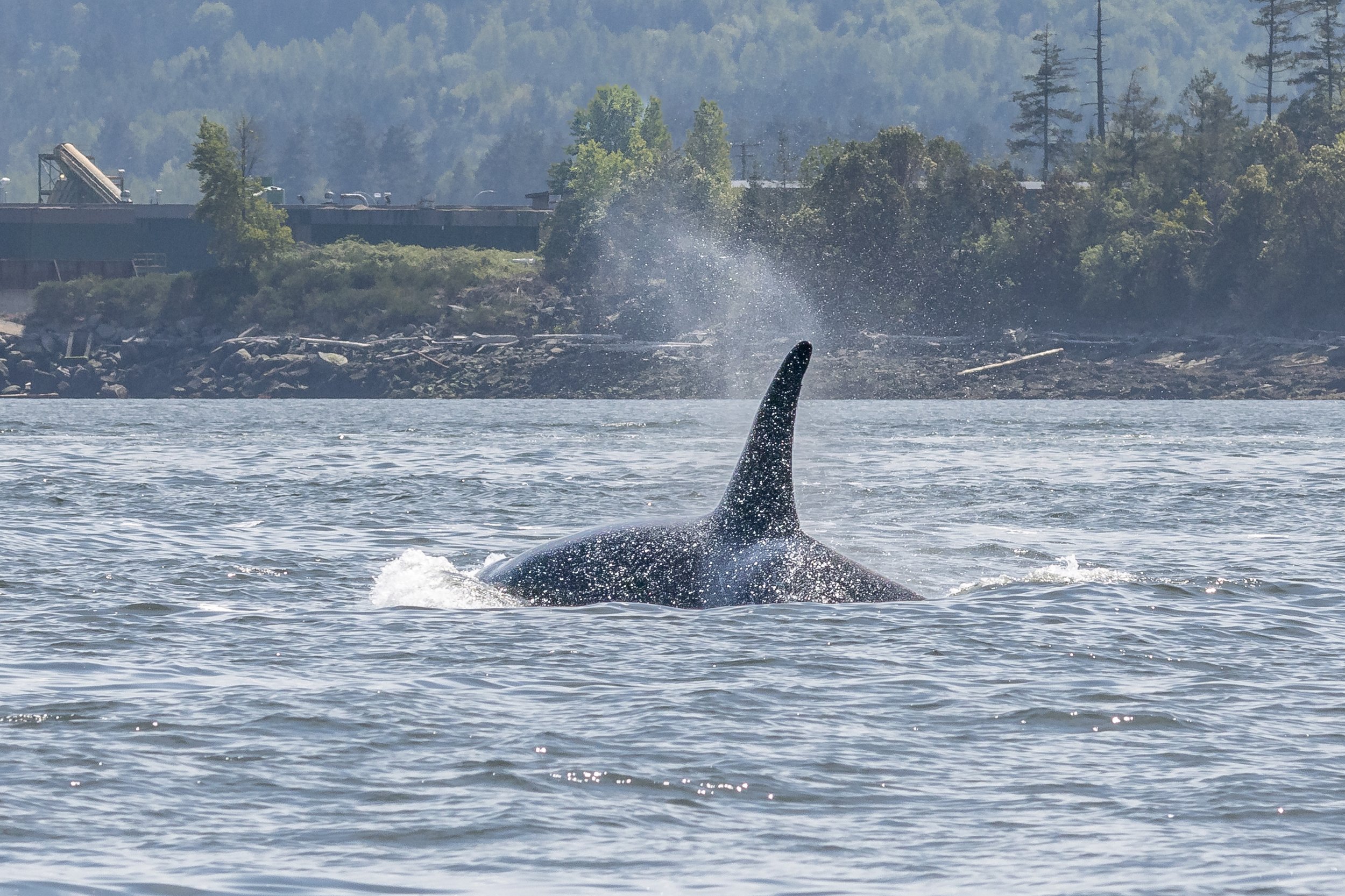May 10, 2023 - The T065A's in the North, and a special encounter with T065A2 Ooxjaa
Conditions were lovely out in the Straight of Georgia this afternoon, with lots of sun and a light breeze. Upon hearing land reports of Orca off of the Yeo Islands, we headed out on our open boat, Keta, moving up towards Nanoose. Only about thirty minutes into the tour, we were able to spot them.
Today we were able to locate (most of) the T065A’s. The pod was quite spread out, with T065A2 “Ooxjaa“ closer towards the shore, T065A3 “Amir” much further out in the straight and the rest of their pod, consisting of T065A “Artemis”, T065A4 “Ellifrit” and T065A6 “Callisto” were in between the two boys today, all slowly travelling south.
T065A5 “Indy” was not travelling with the pod today. This has become a normal occurrence as he has been pod-hopping or travelling solo for the past year. Hopefully, he will come back “home” soon so we can once again see the whole pod together!
The members of the T065A matriline observed today:
T065A Artemis ♀ (1986)
T065A2 Ooxjaa ♂ (2004)
T065A3 Amir ♂ (2007)
T065A4 Ellifrit ♀ (2011)
T065A6 Callisto ♀ (2018)
We stuck around with the girls for just under an hour and headed out further into the straight to see Amir. If you try to ID Amir from his ID photo in the 2019 Photo-identification Catalogue for Bigg’s orca, you likely would not recognize his dorsal fin. He has begun to ‘sprout’ (begin puberty) over the last few years, and he also has a new notch on the tip of his dorsal. Around the time male orcas reach 12-15 years old, they begin their version of puberty and their dorsal fins begin to grow taller. Around this age, their dorsals can appear quite floppy as they begin their growth into a full-grown male. Adult male dorsal fins can be up to 6 feet tall and will reach this height by the time they are about 25 years old. Right now, Amir is only 16 years old. He still has lots of time to go and grow until he gets his full-size adult dorsal fin!
T065A3 Amir as seen in the Bigg’s ID Catalogue, taken in 2017.
T065A3 Amir, May 10, 2023.
After leaving the T065A’s, we began heading south towards Entrance Island to see if we could find some sea lions. There were both Stellar and California sea lions in the mix today. The easiest method used to tell apart the Stellar and California sea lions when at a distance is in the noises they make. The Stellar sea lions make a deep, burp-like sound whereas the Californians make a dog-like barking sound. When up close, you can differentiate Californians because the males have a very large sagittal crest, creating the appearance of a bulging forehead. The Stellar sea lions have a much rounder head and larger males can be upwards of 2500 lbs.
Heading around the east side of Entrance Island, we stopped near Orlebar Point on Gabriola island, where we saw Harbour seals, Cormorants and Harlequin ducks all resting today on one of their favourite rocky outcroppings. The seals were particularly noisy today, croaking at one another which is an unusual occurrence for Harbour Seals. After spending some time with the Harbour Seals, we headed around the western side of Gabriola and met up with a playful whale, one we had seen earlier in the day, but only at a distance - T065A2 “Ooxjaa”! He was playing in the wake behind a large Seaspan vessel when we located him.
Members of the Family Delphinidae, which include orca and dolphins, are some of the only animals known to surface and play in the wake of boats. This behaviour is also known as porpoising. When he was finished porpoising, he slowly turned and headed towards us. We shut off our engines immediately and waited for him to pass, thinking that he might be chasing a seal or sea lion. When he surfaced a few times right next to Keta, we thought that there may be an animal he was hunting hiding underneath our boat. It wasn’t until he began making noises and vocalizing that we realized he was not hunting. We came to this conclusion because transient orca hunt marine mammals that have great hearing, therefore, they will avoid making noise in order to increase their element of surprise. Ooxjaa passed by our boat several times, surfacing and going under our boat multiple times, repeating the same noise over and over and making everyone onboard wonder what he was saying. Was he trying to talk to us or the rest of his family who were a few kilometres behind him? We all have so many questions for Ooxjaa, but we’re sure glad he decided to stop in and say hello.
The rest of Ooxjaa’s pod were in our sights after about 15 minutes of our repeated close encounter with him. Once we spotted them, it looked as if they were calling Ooxjaa back and he listened. He swam back to his mom and siblings, likely with a fun story to tell them about the noisy people on an orange boat and all their “ooo”’s and “aaah”’s. Today with Ooxjaa was truly a one-of-a-kind experience.
Photos today were taken by Naturalist Carmen Murphy.
T065A Artemis and T065A6 Callisto
T065A3 Amir.
T065A3 Amir.
T065A2 Ooxjaa.
T065A2 Ooxjaa.
T065A2 Ooxjaa.
T065A2 Ooxjaa.
T065A2 Ooxjaa.
T065A2 Ooxjaa coming in for a closer inspection.
T065A2 Ooxjaa - Hello there!
T065A2 Ooxjaa.
































